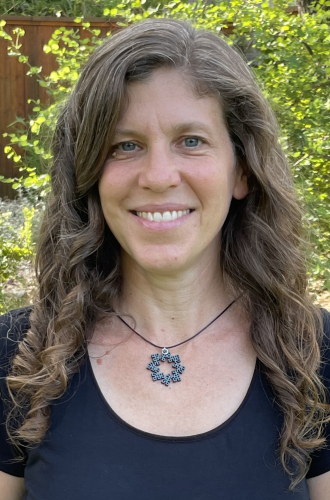-

-

-
Annette M Ostling
Associate Professor, Core Faculty, Oden Institute
Department of Integrative Biology, Oden InstituteI am a community ecologist focusing on competitive coexistence and biodiversity patterns, using mathematical and computational approaches.-
Education
Ph.D. University of California, Berkeley, Energy and Resources, December 2004
M.S. University of Illinois, Urbana-Champaign, Physics, 1999
AB Columbia University, Physics, 1994Professional Appointments
- Associate Professor, Integrative Biology, University of Texas at Austin (2021-present)
- Oden institute Core Faculty, University of Texas at Austin (2021-present)
- Associate Director, Michigan Institute for Computational Discovery and Engineering (MICDE),
University of Michigan, (2016-2021) - Associate Chair of Undergraduate Studies, Ecology and Evolutionary Biology, University of Michigan
(2019) - Miller Institute Visiting Professor, Integrative Biology, University of California, Berkeley (2016) (hosted
by David Ackerly) - Visiting Researcher, Center for Macroecology, Evolution, and Climate, University of Copenhagen
(2015-2016) - Associate Professor, Ecology and Evolutionary Biology, University of Michigan. (2014-2021)
- Assistant Professor, Ecology and Evolutionary Biology, University of Michigan. (2006-2014)
- Council on Science and Technology Postdoctoral Fellow, Ecology and Evolutionary Biology, Princeton
University, Mentor: Simon Levin. (2004-2006)
Lab Website (including info for applicants): https://sites.google.com/umich.edu/ostlinglab/home
Oden Instiute Webpage: https://oden.utexas.edu/people/directory/Annette-Ostling/
-
Biodiversity in nature can be puzzlingly high in the light of competition between species, which arguably should eventually result in a single winner. The coexistence mechanisms that allow for this biodiversity shape the dynamics of communities and ecosystems. My research focuses on understanding the mechanisms of competitive coexistence, how competition influences community structure and diversity, and what insights observed patterns of community structure might provide about competitive coexistence.
Theory development and mathematical and computational modeling dominate in the approaches I take to my research, but I have a particular interest in tightening linkages between theoretical and empirical work, and increasingly my lab is carrying out data analyses as well.
A good portion of my theoretical work is broadly applicable, but I am also especially interested in the coexistence of tree species in forests. Broad theory can only take us so far in determining the coexistence dynamics actually at play in nature. Developing and testing system-specific theory must play a role as well. Forests play a large role in the global carbon cycle, and have high data availability due to a global network of forest census sites. The high diversity of tropical forests is an especially exciting puzzle.
Specific themes that have been a focus of my work include 1) further developing our fundamental understanding of the nature of “niche differences”, i.e. differences between species that lessen competition and stabilize their coexistence; 2) improving our ability to use “neutral theory”, which encapsulates the alternative idea that species coexist through equal abilities, and hence communities are structured by chance, to build process-based null models for detecting the influence of niche differentiation; 3) studying “stochastic niche” models, in which both chance events and species differences are at play, especially in regards to their trait pattern predictions, and uncovering support for those predictions in a tropical forest; and 4) developing a deeper understanding of, and better methods for quantifying the influence of, two key niche differentiation mechanisms that may play a major role in tree species coexistence: successional niche differentiation and differences in enemies.
Additional research interests of mine outside competitive coexistence include macroecological scaling patterns, such as the species-area relationship and related patterns, and their use to estimate diversity loss from habitat destruction and fragmentation, and the influence of large-scale biodiversity loss on ecosystem function (existing work has focused on small scale biodiversity).
-
Selected Publications
Kalyuzhny, M*, JK Lake, SJ Wright, and A Ostling (2023) Pervasive within-species spatial repulsion among tropical trees. Science 381:563. DOI: 10.1126/science.adg7021 Press coverage: New Scientist, Avenir, Le Monde, Quanta.
D’Andrea, R**, J Guittar, J O’Dwyer, H Figueroa**, SJ Wright, R Condit, and A Ostling (2020) Counting niches: Abundance‐by‐trait patterns reveal niche partitioning in a Neotropical forest. Ecology 101:e03019. DOI: 10.1002/ecy.3019
D’Andrea, R**, M Riolo, and A Ostling (2019) Generalizing clusters of similar species as a signature of coexistence under competition. PLoS Computational Biology 15:e1006699. DOI: 10.1371/journal.pcbi.1006688
Rael, R *, R D’Andrea**, G Barabás **, and A Ostling (2018) Emergent niches lead to greater differences between niche and neutral species abundance distributions. Ecology 99:1633-1643. DOI: 10.1002/ecy.2238
D’Andrea, R** and A Ostling (2017) Biodiversity maintenance may be lower under partial niche differentiation than under neutrality. Ecology 98:3211-3218. DOI: 10.1002/ecy.2020
Marquet PA, AP Allen, JH Brown, J Dunne, BJ Enquist, J Gillooly, PA Gowaty, JL Green, D Storch, J Harte, SP Hubbell, J O`Dwyer, J Okie, M Ritchie, A Ostling, and GB West (2014) On theory in ecology. Bioscience 64:701-710. DOI:10.1093/biosci/biu098
Sedio, B** and A Ostling (2013) How specialized must natural enemies be to facilitate coexistence among plants? Ecology Letters 16:995-1003 pdf DOI: 10.1111/ele.12130
Barabás, G**, R D`Andrea**, and A Ostling (2013) Species packing in nonsmooth competition models. Theoretical Ecology 6: 1-19. DOI: 10.1007/s12080-011-0151-z
Ostling, A (2012) Large-scale spatial synchrony and the stability of forest biodiversity revisited. Journal of Plant Ecology 5:52-63. DOI: 10.1093/jpe/rtr035
O’Dwyer, J P, J K Lake*, A. Ostling, V M Savage, and J L Green (2009) An integrative framework for stochastic, size-structured community assembly. PNAS 106:6170-6175.
Ostling, A, J Harte, and J L Green. (2000) Self-similarity and clustering in the spatial distribution of species -Technical Comment. Science 290:671a. pdf
Google Scholar profile: https://scholar.google.com/citations?user=MA4mtZEAAAAJ&hl=en&oi=ao
-
Please see my lab website: https://sites.google.com/umich.edu/ostlinglab/people
Also, if you are interested in applying to work with me, please see: https://sites.google.com/umich.edu/ostlinglab/info-for-applicants
-














